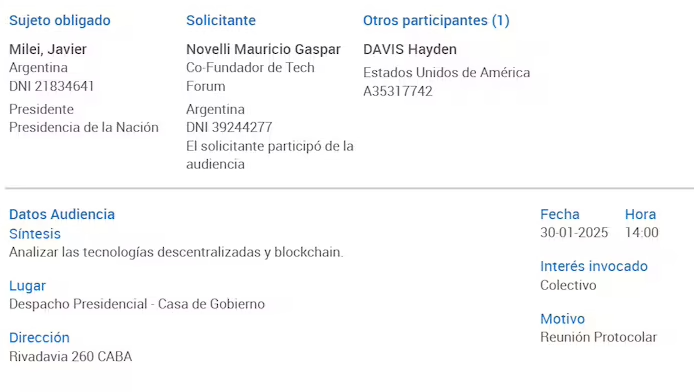
A Tesla drove in the wrong direction, resulting in a head-on collision with another vehicle, during a livestream, demonstrating Tesla’s ‘Full Self-Driving’ features.
more…
A Tesla drove in the wrong direction, resulting in a head-on collision with another vehicle, during a livestream, demonstrating Tesla’s ‘Full Self-Driving’ features.
more…CNN media analyst Brian Stelter, on Bluesky:
As “60 Minutes” finalized its “Inside CECOT” report last Thursday, CBS sent the White House a request for comment. A WH spokesperson responded within a few hours. The quote was not included in the “60” report — so, judge for yourself whether it should have been included or not.
WH spokesperson Abigail Jackson said “60 Minutes should spend their time and energy amplifying the stories of Angel Parents, whose innocent American children have tragically been murdered by vicious illegal aliens that President Trump are removing from the country.”
Despite the fact that it doesn’t address a single aspect of the report, 60 Minutes should have included that statement, both to reveal the belligerent callousness of the administration, and to highlight the glaring grammatical error. In its way, the statement speaks volumes.
Betty Reid Soskin, the National Park Service's oldest ranger, died Sunday. As a ranger, she shed light on the painful reality of working on the WWII home front as a Black woman.
Libra co-creator Hayden Davis and Argentinian president Javier Milei reportedly inked a confidential NDA 15 days before the token’s launch that officially cemented Davis’s role as the project’s advisor.
As reported by local news outlet Clarín, the contract, which was signed on January 30, stipulated that Davis would give unpaid blockchain advice “ad honorem.”
It also detailed how he would “provide professional support, in line with global trends in decentralization and technological modernization, ensuring the highest quality and confidentiality at every stage of the advisory process.”
Read more: LIBRA website vanishes with millions in project funds on the move
Specifically, Davis would advise on smart contracts and their use in improving government efficiency, the implementation of blockchain training programs for public officials, promoting startups focused on blockchain technology, and storing public documents within blockchains.
Hours after the contract was signed, Milei uploaded a selfie of himself and Davis with the caption, “[Davis] advised me on the impact and applications of blockchain technology and artificial intelligence in the country.”
Just 42 minutes after this photo was uploaded, $507,400 worth of USDC was sent from a wallet linked to Davis to a wallet on the Bitget exchange.
A report from the Secretariat for Financial Investigation and Recovery of Illicit Assets (SIFRAI) details how another $507,000 was also sent from a Davis-linked wallet that day.
Both payments were sent to 75-year-old Orlando Rodolfo Mellino’s wallet before being forwarded to another wallet. The report suggests that Mellino may have been an intermediary and “exit ramp” for Davis to convert the crypto into fiat.

Davis sent more funds to other wallets in the run-up to Libra’s February 14 launch, some of which ended up in the hands of a crypto promoter called Camilo Rodríguez Blanco. The report found that altogether, Davis had sent almost $5.7 million from his wallets.
Clarín reports that lobbyists Mauricio Novelli and Manuel Terrones Godoy, who were present when Davis and Milei signed their agreement, acted as a “gateway” for the pair to connect.
Family members related to the lobbyists were filmed on February 14 withdrawing funds from two safe deposit boxes previously opened by Novelli.
La Nación reports that the confidential agreement also reveals that Milei had omitted key information about his interactions with Novelli and Terrones Godoy, and that he’s never disclosed the contract to the press.
Read more: Javier Milei disapproval rate hits 60% in Argentina after LIBRA scandal
More recently, in a US case put forward by victims of the Libra scandal, an order requesting the restriction of Libra-linked funds was denied by a judge.
Before the hearing, a new, seemingly rushed, Libra Trust website was launched that promised to distribute the funds to Argentinian startups as initially promised before the Libra scandal.
The site, however, isn’t clear about who would be overseeing this.
Got a tip? Send us an email securely via Protos Leaks. For more informed news, follow us on X, Bluesky, and Google News, or subscribe to our YouTube channel.
The post Javier Milei hired Hayden Davis with secret contract, report appeared first on Protos.


The Federal Communications Commission has banned new drones made in foreign countries from being imported into the US unless the Department of Defense or the Department of Homeland Security recommends them. Monday's action added drones to the FCC's Covered List, qualifying foreign-made drones and drone parts, like those from DJI, as communications equipment representing "unacceptable risks to the national security of the United States and to the safety and security of U.S. persons."
DJI is "disappointed" by today's action, Adam Welsh, DJI's head of global policy, says in a statement. "While DJI was not singled out, no information has been …
Archivists have saved and uploaded copies of the 60 Minutes episode new CBS editor-in-chief Bari Weiss ordered be shelved as a torrent and multiple file sharing sites after an international distributor aired the episode.
The moves show how difficult it may be for CBS to stop the episode, which focused on the experience of Venezuelans deported to El Salvadorian mega prison CECOT, from spreading across the internet. Bari Weiss stopped the episode from being released Sunday even after the episode was reviewed and checked multiple times by the news outlet, according to an email CBS correspondent Sharyn Alfonsi sent to her colleagues.
“You may recall earlier this year when the Trump administration deported hundreds of Venezuelan men to El Salvador, a country most had no connection to,” the show starts, according to a copy viewed by 404 Media.
Multiple social media users noticed on Monday that the 60 Minutes episode was available via the Global TV app. To view the episode, viewers need to connect to the app from a Canadian IP address.
People then uploaded copies of the episode to a variety of file sharing sites and services, including iCloud, Mega, and as a torrent. Even political commentator Mueller She Wrote uploaded a copy.
According to Alfonsi’s email, which was widely leaked shortly after she sent it, she learned Weiss “spiked” the 60 Minutes episode, called INSIDE CECOT on Saturday.
“Our story was screened five times and cleared by both CBS attorneys and Standards and Practices. It is factually correct. In my view, pulling it now—after every rigorous internal check has been met is not an editorial decision, it is a political one,” the email read.
Weiss was recently appointed to the editor-in-chief of CBS News after Paramount acquired Weiss’s website The Free Press in October. Weiss garnered a reputation on the right as something of a fearless truth teller after she quit the New York Times as an opinion writer in 2020. In reality, stories published by The Free Press are often contrarian and fundamentally flawed, such as one that attempted to show that children who starved to death in Gaza already had underlying health conditions.
Weiss’s appointment as the head of CBS News brought fears she might have one of the most respected journalism institutions do much the same work as her website, or deliberately bow to the Trump administration.
In a memo Weiss sent to top 60 Minutes brass, obtained by Axios, she said the episode left out comment and perspective from administration officials. In her earlier email, Alfonsi said CBS News requested comment or sought interviews with the Department of Homeland Security (DHS), the White House, and the State Department. “Goverment silence is a statement, not a VETO. Their refusal to be interviewed is a tactical maneuver designed to kill the story,” she wrote.
The Trump administration has repeatedly claimed that the men sent to El Salvador were overwhelmingly violent criminals; Pro Publica reported that the administration knew at least 197 of the men had not been convicted of crimes in the United States, and six had been convicted of violent offenses.
404 Media previously used hacked data from GlobalX, one of the airlines supporting ICE’s deportations, which showed at the time dozens of unknown people on three deportation flights to El Salvador.
CBS did not immediately respond to a request for comment.
